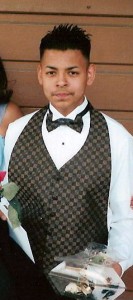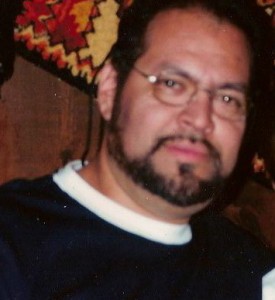Richard Flores, 42
Sylvia Flores, 13
Matthew, 10
Richard Jr., 17 . . .all murdered
. . .and Mother Sylvia wounded. 




July 21, 2000 – Pico Rivera, California: Offenders Michael and Monica stabbed Richard Flores, 42, his wife, Sylvia, and three of their children — young Sylvia, 13, Matthew, 10, and Richard Jr., 17. Of the five, only the elder Sylvia survived. Monica was Flores’ niece who they were raising. They took her into their home out of the goodness of their hearts, and loved her as their own, because her mother could not raise her. Monica was 16 when she murdered the Flores family and was later sentenced to life in prison.
Surviving the rampage were Monica’s half sister, Laura Reta, and the eldest Flores daughter, Esperanza, who were both 18 and shared a bedroom. Boyfriend Michael did most of the stabbing but that Monica’s “involvement in this crime is equal to” that of her partner, says sheriff’s Sgt. William Marsh, lead investigator on the case.
Syliva attended the Parents of Murdered Children Conference, devastated beyond words. Her family gone, her life destroyed, still having to face new trials and appeals for the teen killer, her niece she had taken in and raised. How could words even describe this agony?
Her whole family.
How could anyone know the full depth of this horror.
Sentence upheld for young woman convicted of killing family in Pico Rivera in 2000
The three-justice panel from California’s 2nd District Court of Appeal rejected Monica Diaz’s claims that Norwalk Superior Court Judge John A. Torribio abused his discretion in imposing the term and that her August 2009 sentence constituted cruel and unusual punishment.
“Admittedly, defendant’s sentence is severe, she was young when she committed the crimes, she has no prior criminal record, and there was evidence to support a finding that she suffered enduring psychological effects of her difficult early childhood years,” Acting Presiding Justice Robert M. Mallano wrote on behalf of the panel.
“But when her sentence is viewed in light of the number and gravity of her commitment offenses, it is not an extreme or grossly disproportionate sentence and does not violate the Eighth Amendment.”
Diaz – who was 16 at the time of the attack – was convicted in February 2004 of first-degree murder for the slayings of her uncle, Richard Flores, 42, and cousins Richard, 17, Sylvia Jr., 13, and Matthew, 10, who were attacked in the early morning hours of July 21, 2000.
Diaz’s high school sweetheart, Michael Naranjo, pleaded guilty to the murders in October 2003 and was sentenced to life in prison without the possibilityof parole.During her trial, Diaz testified that she and Naranjo agreed to stage a fake robbery at the home to draw her family closer because she believed her aunt and uncle – who took her in after her mother died – were having marital problems.
Diaz acknowledged cutting duct tape for her then-17-year-old boyfriend so her family could be tied up. But she denied taking part in the murders.
During her trial, the prosecution presented a March 1999 letter in which Diaz wrote to Naranjo that the “best job is to kill people professionally.” She testified that the missive was “just words.”
Diaz was first sentenced in April 2004 to life in prison without the possibility of parole, but an appellate court panel reversed a special circumstance allegation of multiple murder, along with her conviction for the attempted murder of her aunt and adoptive mother, Sylvia Flores, who survived the attack.
In its December 2005 ruling, the appellate court panel found the trial court “erroneously limited consideration of evidence that defendant thought her boyfriend would only frighten the people inside the house by pretending to rob them and did not know of his plan to kill.”
Prosecutors opted not to re-try the attempted murder count or the multiple murder allegation. She was re-sentenced in April 2007 – that time to four consecutive 25-year-to-life terms. But a three-judge panel from the 2nd District Court of Appeal ruled that a lower court judge should have granted a continuance to allow Diaz’s attorney more time to prepare, requiring another sentencing hearing in 2009.
At Diaz’s August 2009 sentencing, her aunt was among those calling for the harshest possible sentence.
“I want her to get life — four life sentences … nothing less … I fear for this community if she were to come out,” Sylvia Flores told the judge.
Calling it the “most horrific situation I’ve been involved in,” the judge noted that the family had opened their door to Diaz and her half-sister after their mother died and treated her like their own.
The judge said at the August 2009 hearing that he believed there was “no other sentence that is appropriate other than four consecutive life sentences,” noting the victims were “massacred in their own home” and that the crimes should be “punished individually.”
The judge then sentenced her to the identical 100-year-to-life term he had imposed in 2007.
Read more: http://www.sgvtribune.com/ci_17949649?source=email#ixzz1KwNNPU7F
Murder in the Family
By CARLA HALLNOV. 16, 200212 AMTIMES STAFF WRITER
In a family of beautiful girls, Monica Diaz was the chunky one. “They called me Chubby Checkers,” she says.
She was a Diaz living with the Flores family — a niece living with her aunt and uncle and their children.
The only person she felt she belonged with was Michael Naranjo. While her family teased her about her weight, the boy told her she was beautiful.
“When Michael came along, he was so easy to talk to,” she says. “He used to say, ‘I love you so much. No one will ever appreciate you like I do.’ He used to call me his Cinderella.”
She smiles sheepishly as she tells her story, her wrist chained to a wall at the Twin Towers jail in Los Angeles. In jail-issue blue top and baggy pants, she sits in a visiting booth on a fall afternoon, clasping the phone receiver behind a glass wall. She turned 19 on Halloween.
Michael, also 19, sits one jail tower away. Both are charged with four counts of murder and one of attempted murder. Both have entered not-guilty pleas.
In the early hours of July 21, 2000, authorities allege, Michael stole into the four-bedroom Flores home in Pico Rivera and, with Monica’s help, stabbed Richard Flores, 42, his wife, Sylvia, and three of their children — young Sylvia, 13, Matthew, 10, and Richard Jr., 17. Of the five, only the elder Sylvia survived.
Untouched in the rampage were Monica’s half sister, Laura Reta, and the eldest Flores daughter, Esperanza, who were both 18 and shared a bedroom.
Authorities allege that Michael did most of the stabbing but that Monica’s “involvement in this crime is equal to” that of her partner, says sheriff’s Sgt. William Marsh, lead investigator on the case.
Naranjo and Diaz spoke in separate interviews this fall, their first since being jailed.
Sitting behind glass partitions in their respective towers, they appear mild-mannered and affable. He smooths back his longish hair as he names his favorite bands and speaks respectfully of his girlfriend’s uncle, the man he is charged with knifing to death. She is given to giggles and occasional tears as she talks about the family she is accused of plotting to kill.
She says she harmed no one and found out about the alleged plot only after the stabbings. “I’ll have to live with the fact that I didn’t tell anyone about what happened,” says Monica, who has a court-appointed attorney.
She won’t call Michael the killer but says: “Michael does feel bad for everything that happened…. I know if he could go back in time, none of this would have ever happened.”
Michael, who is represented by a public defender, won’t discuss the attack but describes how he feels about the deaths.
“Sad,” he says. “You read about these things in newspapers. Then something like this comes along and it’s 10 times worse.”
Which leaves the question: Why would Michael and Monica massacre most of her family?
She describes a life that evokes the name Michael gave her, Cinderella — the girl treated dismissively by her family but like a princess by her boyfriend.
Monica says she knows that her family has “suffered a lot these past two years, but this gets so one-sided. They make it sound like ‘The Brady Bunch,’ but it wasn’t.”
It was a blended family. Sylvia and Richard Flores were raising their children as well as the two daughters of Sylvia’s sister, who died in 1987. Monica and Laura had different fathers but were raised together. They shuttled between their maternal grandmother and their Aunt Sylvia.
Monica was 8 when she and Laura moved permanently into the Flores house. Bedroom space was tight, so some kids slept two to a bed. Never officially adopted, Monica and Laura got the same discipline and love as the other children, say family friends.
Sylvia handled medical claims for a group of doctors, and devoted the rest of her time to her children. Richard rose up through the ranks of a custom woodworking company to become a purchasing agent. He was 6 feet 9 and fond of gold jewelry, an affectionate father who liked to tease and was protective of all the girls, by most accounts.
But Monica was unhappy. There’s a teen angst to her complaints: When she played basketball to please her sports-obsessed family, her aunt and uncle sometimes missed her games. They were always there when Esperanza, a city-ranked high school player, or little Sylvia, a budding phenomenon, played.
The elder Sylvia, Esperanza and Laura describe a family that traveled together in their 12-seat van. They squabbled and teased and laughed together. “We were a combination of ‘Cosby’ and ‘Roseanne,’ ” says Sylvia.
They were proud of Monica’s intelligence — she helped the others with their homework — and never forced her to play sports. Sure, Sylvia says, they missed a few of Monica’s games but never during summer league. Sylvia says the children’s taunting “wasn’t to the heart. They had their disagreements with each other, but the next minute you saw them hugging. Despite what she says, we were a real good family.”
Monica says she kept her feelings inside. Then she began dating Michael in April 1999. They met in Junior ROTC at El Rancho High School. He became her confidant, her boyfriend, the biggest fan at her games. They walked to class together, and after school spent hours on the telephone. They marked each other with hickeys, and left bruises from their roughhousing.
She dreamed of studying biology, Michael of being a Marine. But when his grades slipped, his parents forced him to quit ROTC, court records say. “If he had stayed in ROTC, senior year he would have been commander of the platoon,” says Monica, who also quit.
Monica’s family and friends say Michael was an introspective teenager who dressed in black. He liked to collect knives. “I thought it was an ROTC thing,” said Daniel Gonzales, Monica’s friend and neighbor.
Michael denies the story, circulating since his arrest, that he was a black-coated Goth steeped in punk music.
“I listen to lots of stuff,” he says from a visiting booth in jail, his dark hair pulled into a ponytail, close-cropped on the sides, a tiny hoop earning in each lobe. “My five bands are Queen, Nirvana, the Beatles, Metallica and Green Day.”
As for his knife collection, he says, “That’s a long story.”
Monica says he gave her three. He also collected Zippo lighters, one of which he converted into a tiny flashlight for Monica, engraving it “For My Little Munchkin.”
“I’m scared of the dark,” Monica says with a giggle.
He gave her jewelry and videos. One day at school, she says, she was craving chili cheese fries, so he ran to a taco stand and returned, red-faced and sweaty, with her order.
He also had a temper, she says: “Michael, he’s nice, but when he gets mad, it’s everybody run and hide. After being with Michael a few months, people at school said, ‘If you break up with him, tell me the day before so I won’t come to school.’ ”
Michael may not have been a parent’s idea of the perfect boyfriend, but the elder Floreses thought it wise to embrace him. Richard Flores once took his prized samurai sword from a safe to show a fascinated Michael, Sylvia says. The boy came for dinner, picnics and birthday parties. “He was over too much,” remembers Sylvia. “We wanted him to go home.”
Sylvia says she felt sorry for him. Monica, she says, told her Michael had tried to commit suicide four times, something Monica denies.
But as summer 2000 approached, Richard Flores was growing increasingly worried about the relationship. He thought Michael was weird. Sneaky, he told Monica.
Michael says he has no complaints about Richard: “He was keeping an eye out — making sure I was an all-right guy. They were all pretty nice to me.”
*
On the night of July 20, 2000, little Sylvia and Monica played together in an El Rancho High summer league basketball game.
In the stands sat most of her family. But Michael wasn’t there. He didn’t have a ride.
When they got home, Monica and little Sylvia climbed into the bed they shared. Esperanza, the last to arrive home, bid her parents good night and slipped into her bunk bed in the room she shared with Laura. She phoned a cousin to chat, then drifted off to sleep about 1 a.m.
Sometime later, Michael allegedly entered the house through the back door that investigators say Monica had left unlocked.
Police say the killers moved through the house swiftly and methodically.
They had two locking-blade knives, a balisong — or butterfly — knife favored for hand-to-hand combat, a double-edged throwing knife and a dagger. The handles of some of the knives were wrapped with cord and cloth tape, for a better grip, according to investigators.
They started with little Sylvia. She was stabbed repeatedly, from her throat to her abdomen, a piece of silver duct tape left dangling from her cheek.
In the next room, Richard Jr. was knifed and slashed across his throat. Matthew was partly disemboweled.
Michael, investigators allege, next made his way to Richard and Sylvia’s bedroom. A sleeping Sylvia was stabbed first. She awakened to see her husband struggling with an assailant she could not make out in the dark.
With her foot, Sylvia says, she pushed against the attacker, surprising him and prompting him to jump off the bed. He stumbled back and left the room, closing the door behind him.
Michael escaped on his bicycle and rode 2 1/2 miles home to his parents’ house, according to investigators.
Meanwhile, Esperanza was awakened by sounds from her parents’ room. As the back door was shut, she heard the rattle of the ceramic chili peppers strung outside. She went to the hallway and saw her father clutching his throat. He fell to the floor.
“Call 911,” said her mother, lying on the bed. She had been stabbed in her chest, her torso and chin. Esperanza tried the phone, but the line was dead. She ran across the street to the house of Manuel and Helen Yglesias and pounded on their door. The couple called police, then went to the house with Esperanza.
“We could hear Laura screaming,” remembers Manuel Yglesias. “The whole neighborhood could hear her.” Inside the house, Esperanza saw Monica ministering to her aunt’s wounds.
“It’s so ironic,” says Monica now. “Everyone said, ‘If you hadn’t applied direct pressure, she would have died.’ ”
Monica told detectives she had gotten out of bed to use the bathroom and, while there, heard footsteps. Frightened, she didn’t budge until she heard her sisters’ voices, she told authorities.
Investigators say they found two knives in that bathroom. Later that day, Sgt. Marsh showed Monica crime scene photos of the knives in the bathroom.
“Yeah, that’s a butterfly knife. I have one just like it,” she told Marsh, according to court records. But she insisted that they weren’t there when she was hiding.
The following day, Esperanza, Laura and Monica were called to the sheriff’s station. Monica took Michael along. He agreed to be interviewed.
A bandage on his forearm caught the attention of investigators. He first said troublemakers at school had thrown broken glass at him, authorities said, and without being asked, he peeled off the bandage.
It was a diagonal straight edge. That doesn’t look like a glass cut, the investigators told him. Michael changed his explanation — he had cut himself with a razor blade intentionally but didn’t want Monica to know. The next day, investigators began following him.
Within a few days, investigators matched Monica’s and Michael’s fingerprints with the prints on the knives and duct tape found at the home. They also identified Michael’s fingerprints on batteries inside a military-style flashlight found in the Flores house.
Five days after the killings, detectives arrested Monica at the home of one of Sylvia Flores’ brothers.
Shortly afterward, Marsh found Michael at his parents’ dining room table eating a Burger King Whopper. Out of deference to his parents, Marsh took him outside to handcuff him.
A search of the house turned up more than 15 knives, a manual on close combat, a book on serial killers and a book called “Stalk to Kill.” In the garage, authorities said, they found a spool of white cord — the same kind used to wrap the knives’ handles — and blood on Michael’s bicycle.
The next week, close friends and family gathered for a private viewing of the four open caskets. Sylvia, still recovering from wounds, attended in a wheelchair. She drew Esperanza and Laura close to her.
“You love your sister, you hate what she did, and she will pay the price,” Sylvia told them. “But she is still your sister.”
*
In the two years since she was nearly killed, Sylvia Flores has refashioned her life. She fulfilled her dream of being a hairdresser. She took up bowling again. She celebrated her 40th birthday this year with a party. She returned to the house on Marjorie Street and lived there more than a year.
“Why not?” she says. “This was my house for 16 years. There are no bad memories. Except for that day.”
Recently, though, she moved out, renting it to friends. It had gotten too big for her.
Esperanza, 21, is a full-time student at the University of La Verne. Laura Reta, 20, works, attends Bryman College and lives with her boyfriend in Los Angeles. This summer she gave birth to a daughter, Ashley. Sylvia attended the delivery.
An inch-long scar traces a diagonal path across Sylvia’s chin. “I hate it,” she says.
She refuses to see or speak with Monica, preferring to wait for the trial.
Meanwhile, the case trudges from one minor court hearing to another. One is scheduled for next week. Sylvia goes to all of them, frustrated at the slow pace. A trial could begin in January, prosecutors say.
“I can’t hate her,” says Sylvia Flores. “I don’t know what drove her to that point.”
One time Monica got her on the phone, and Sylvia scolded her.
“She’s guilty of something,” Sylvia says. “She didn’t say to me, ‘Help, Mom, get me out, I had nothing to do with it.’ She said, ‘You don’t know what happened.’ ”
Her cousin, Esperanza, visited Monica and came away unmoved by Monica’s tears.
“She’s a faker,” says Esperanza. “She read a lot of books on how murderers get off.”
In the more than a year she was in juvenile hall, the 5-foot-3 Monica says, she ballooned from 172 pounds to 250.
“All I wanted to do was sleep and eat,” she says. These days, she exercises and has taken up drawing. She’s down to 165 pounds.
The only time she ever sees Michael is in court. But he writes her letters.
Sentence upheld for young woman convicted of killing family in Pico Rivera in 2000
By CITY NEWS SERVICE | [email protected] |PUBLISHED: April 28, 2011 at 12:00 a.m. | UPDATED: August 30, 2017 at 9:33 a.m.
LOS ANGELES – A state appeals court panel Thursday upheld a 100-year- to-life prison sentence for a young woman convicted along with her boyfriend of the July 2000 stabbing murders of four members of her adoptive family as they slept in their Pico Rivera home.
The three-justice panel from California’s 2nd District Court of Appeal rejected Monica Diaz’s claims that Norwalk Superior Court Judge John A. Torribio abused his discretion in imposing the term and that her August 2009 sentence constituted cruel and unusual punishment.
“Admittedly, defendant’s sentence is severe, she was young when she committed the crimes, she has no prior criminal record, and there was evidence to support a finding that she suffered enduring psychological effects of her difficult early childhood years,” Acting Presiding Justice Robert M. Mallano wrote on behalf of the panel.
“But when her sentence is viewed in light of the number and gravity of her commitment offenses, it is not an extreme or grossly disproportionate sentence and does not violate the Eighth Amendment.”
Diaz – who was 16 at the time of the attack – was convicted in February 2004 of first-degree murder for the slayings of her uncle, Richard Flores, 42, and cousins Richard, 17, Sylvia Jr., 13, and Matthew, 10, who were attacked in the early morning hours of July 21, 2000.
Diaz’s high school sweetheart, Michael Naranjo, pleaded guilty to the murders in October 2003 and was sentenced to life in prison without the possibility of parole.
During her trial, Diaz testified that she and Naranjo agreed to stage a fake robbery at the home to draw her family closer because she believed her aunt and uncle – who took her in after her mother died – were having marital problems.
Diaz acknowledged cutting duct tape for her then-17-year-old boyfriend so her family could be tied up. But she denied taking part in the murders.
During her trial, the prosecution presented a March 1999 letter in which Diaz wrote to Naranjo that the “best job is to kill people professionally.” She testified that the missive was “just words.”
Diaz was first sentenced in April 2004 to life in prison without the possibility of parole, but an appellate court panel reversed a special circumstance allegation of multiple murder, along with her conviction for the attempted murder of her aunt and adoptive mother, Sylvia Flores, who survived the attack.
In its December 2005 ruling, the appellate court panel found the trial court “erroneously limited consideration of evidence that defendant thought her boyfriend would only frighten the people inside the house by pretending to rob them and did not know of his plan to kill.”
Prosecutors opted not to re-try the attempted murder count or the multiple murder allegation. She was re-sentenced in April 2007 – that time to four consecutive 25-year-to-life terms. But a three-judge panel from the 2nd District Court of Appeal ruled that a lower court judge should have granted a continuance to allow Diaz’s attorney more time to prepare, requiring another sentencing hearing in 2009.
At Diaz’s August 2009 sentencing, her aunt was among those calling for the harshest possible sentence.
“I want her to get life — four life sentences … nothing less … I fear for this community if she were to come out,” Sylvia Flores told the judge.
Calling it the “most horrific situation I’ve been involved in,” the judge noted that the family had opened their door to Diaz and her half-sister after their mother died and treated her like their own.
The judge said at the August 2009 hearing that he believed there was “no other sentence that is appropriate other than four consecutive life sentences,” noting the victims were “massacred in their own home” and that the crimes should be “punished individually.”
The judge then sentenced her to the identical 100-year-to-life term he had imposed in 2007.





